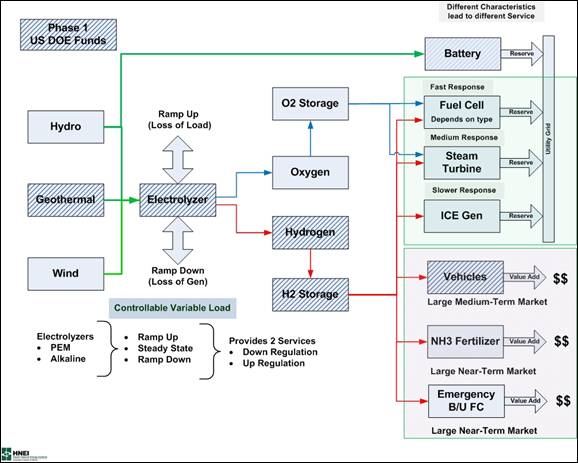We may soon see hydrogen buses carrying passengers here on the Big Island.
Rick Rocheleau, Director of the Hawaii Natural Energy Institute (HNEI), just gave me a glimpse into the future when he talked about a project he has submitted to the Department of Energy for funding.
Basically, he will take geothermal-generated electricity and run it through water to separate the hydrogen. A mobile fueling station will fuel up five hydrogen buses, which will be run by the County Transit Service.
Later, when the project moves into Phase 2, the hydrogen can be converted into ammonia, which can then be used for fertilizer and as an energy carrier.
Ammonia is more energy-dense than straight hydrogen. Maybe we could store it in a strategic reserve. Just thinking out loud.
From Dr. Rocheleau’s presentation:
The objective of this program is to evaluate the feasibility of utilizing a hydrogen production and storage system as a grid management tool to mitigate the impacts of renewable energy sources such as wind, solar, and geothermal, on the Big Island. Hydrogen produced from the system would be used for a variety of value-added products, including use as a transportation fuel, as a fuel for stationary fuel cell products, and if budget allows in Phase 2, continue development of hydrogen as a chemical feedstock for the production of ammonia to be used as fertilizer and / or a chemical hydrogen carrier. Optimized use of the electrolyzer, storage and secondary generation, and high value products is intended to increase the use of renewable energy resources, and reduce barriers to the introduction of the hydrogen infrastructure required to advance the “Hydrogen Economy.”
The following figure provides a conceptual illustration of a renewable hydrogen energy system used to produce hydrogen for energy, fuel, and chemical feedstock while also providing grid ancillary services.
Figure 1: Hydrogen Energy SystemThe system has three main components. The first component is an electrolyzer that operates as a controllable load that provides ancillary services to the grid. A second component, shown in the box on the lower right of the figure, is a set of value added products that utilize hydrogen for transportation fuels and producing fertilizer. The third main component of the system, shown in the box on the upper right of the diagram, is additional grid services enabled by the hydrogen and oxygen produced by the electrolyzer. The latter box shows three different potential electricity generating technologies than can used to produce power for additional grid services: fuel cell, steam turbine, and internal combustion engine.
A unique element of the overall program is the demonstration of the electrolyzer as a controllable variable load that can potentially provide grid services such as:
· Up regulation
· Down regulation
· Off peak load (relieving curtailment of as available renewable energy)In this mode, the electrolyzer would be operated around a production rate that would be determined by the demand for transportation fuels, auxiliary power, and chemical feedstock. The electrolyzer would have the ability to reduce its load (ramp down) in response to a loss of generation on the system. This capability to quickly drop load is equivalent to up regulation carried by generating units on the system. The hydrogen energy system could also provide quick-responding increase in load (ramp up) that would be useful in loss-of-load events, such as a loss of transmission lines. For this service, the difference between the maximum capacity of the electrolyzer and the steady state defines the ability of the electrolyzer to provide down regulation.


